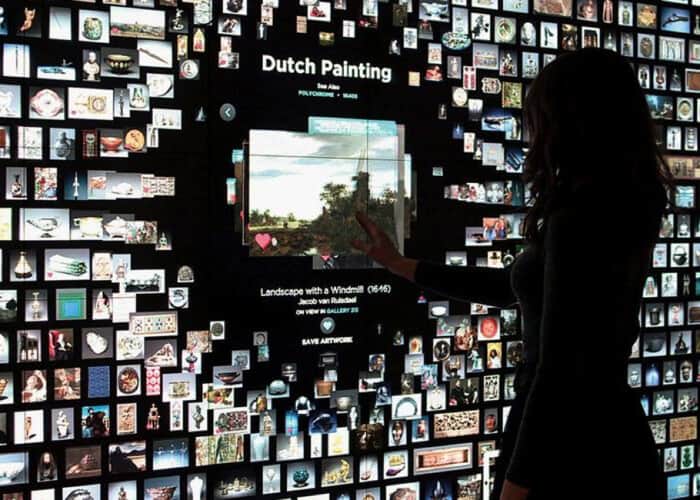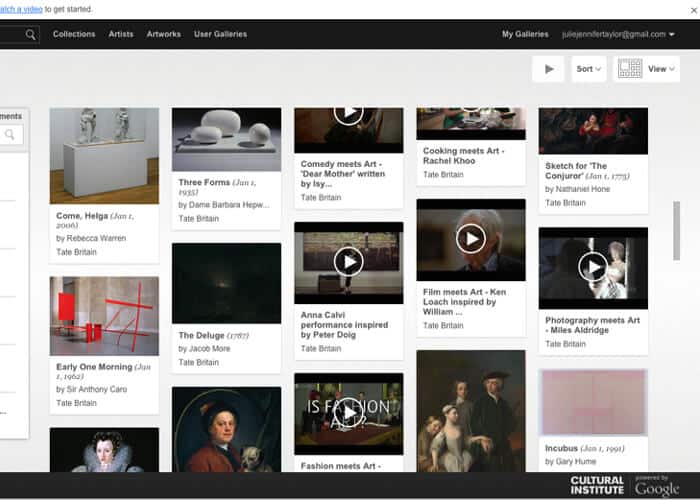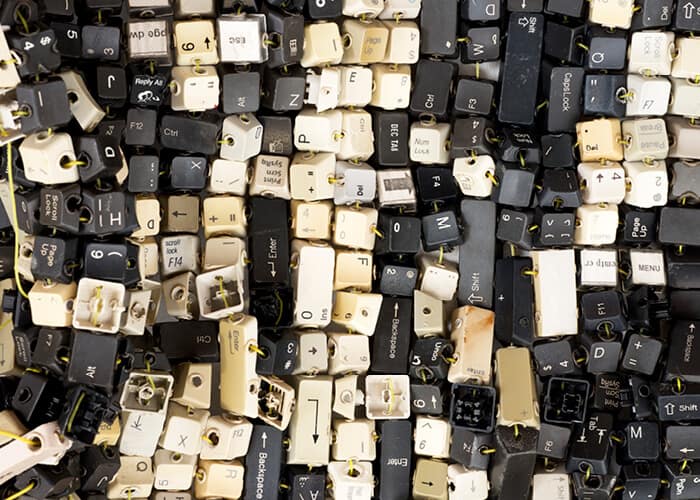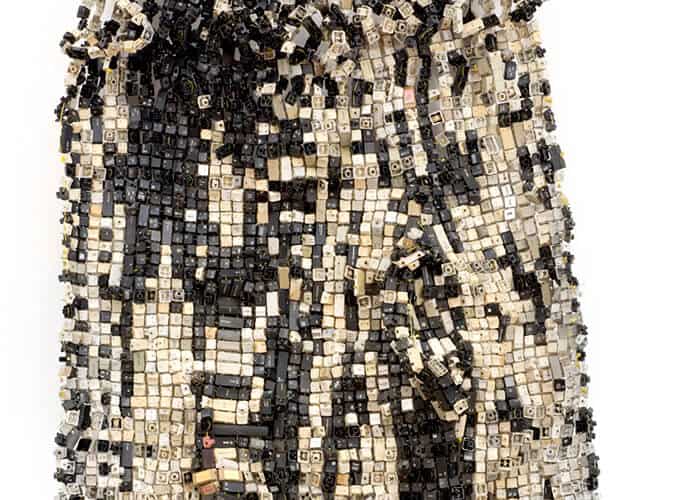Dr. Julie Taylor, the founder and director of the online art platform Guns & Rain, writes about the rise of the Internet and of new, rapidly-evolving web technologies that have had profound consequences for all aspects of society and economy, in particular for the flow of information. This article explores some of the implications of the Internet for exhibition and curatorial practices.
 Collection Wall at the Cleveland Museum of Art’s Gallery One, winner of the Best of the Web award in 2014 for the Digital Exhibition category. Image courtesy Cleveland Museum of Art.
Collection Wall at the Cleveland Museum of Art’s Gallery One, winner of the Best of the Web award in 2014 for the Digital Exhibition category. Image courtesy Cleveland Museum of Art.
How are museums and institutions using new technologies, what are the implications for audiences and publics, and what are some of the practical and epistemological concerns therein? In turn, how should we think about the rise of online exhibitions? In the politics of online curating, it is clear, as Premesh Lalu (2007) has persuasively argued, that “technology is not mere mediation” and there are new intellectual challenges that arise in the wake of society’s growing dependence of knowledge on technology.
The art history literature has amply analysed and significantly critiqued the role of the curator as ‘mediator’, ‘author’, ‘undertaker’, ‘iconoclast’ and so on (for example, Anton Vidloke 2010, Boris Groys 2008, Chika Okeke-Agulu 2008). The rise and application of new technologies in exhibition and curatorial practice, however, adds a complex dynamic to the curator’s role, arguably creating a ‘double layer’ of mediation as the relationship between the virtual/digital and physical assumes an increasingly important role.
New technologies have dramatically changed the ways in which publics access information. Since the late 1990s, understanding how institutions use and deploy technology and, conversely, understanding online audience behaviour has become a new profession and area of expertise. Museums are using (or could use) the web and social media in many new ways, and this affects publics’ access and experience of exhibitions and related information. Yet as Antonio Padilla and Ana Rosa del Aguila (2013) show, there is a surprising sparsity of research in this area.
 Screenshot of some of Tate Britain’s searchable online asset repository available via the Google Cultural Institute. Accessed 14th September 2015. https://www.google.com/culturalinstitute/u/0/browse/tate?q.8129907598665562501=78974797&q.openld=8129907598665562501&projectld=art-project.
Screenshot of some of Tate Britain’s searchable online asset repository available via the Google Cultural Institute. Accessed 14th September 2015. https://www.google.com/culturalinstitute/u/0/browse/tate?q.8129907598665562501=78974797&q.openld=8129907598665562501&projectld=art-project.
Most often, virtual displays complement real displays, or provide a window into collections which are not permanently on display. The web has often been seen as the answer to the ‘problem’ of museums or institutions not having enough physical space to do justice to large collections. Padilla and del Aguila (2013) and Cesar Carreras & Federica Mancini (2014) give some examples of how museums/institutions are using the web, and the Google Cultural Institute website provides dozens of examples of online materials shared by well-known global art institutions. In addition to these examples, there is also a rise of online-only exhibitions.
Just a few of the questions that we might ask include: Does a museum have a website? If so, what kind of information does it disseminate, and what is the related intention? Does it include only basic information for visitors, such as opening hours and exhibition overviews? Does it actually present images of some or all of a current exhibition, or perhaps images of some of the institution’s collection? Does it have repositories and/or online-only exhibitions? (see Graciela Kahn 2014). Furthermore, is the real exhibition echoed by an online exhibition, and how long does the online exhibition ‘live’? What does this mean for how exhibitions are remembered, and by whom? A related question is whether online displays are also integrated into real displays – for example, interactive digital screens and monitors being included in the same physical space as artworks or artefacts.
Next, once exhibition-related content is brought onto the web, what kind of online visitor behaviour is subsequently observed? Does the website provide opportunities for online visitors to interact with or respond to these images – to leave comments, for example, save an image to their own technology device, or share what they find via social media? Related to this, where do online visitors come from? Are they from the same or different geographies demographic(s) as real visitors, and what does this mean? How long do they spend on the website, and where exactly do they spend their time? Do they only visit once, or do they come back for more? Does their experience or learning change over the course of multiple visits? What does this mean for the ways in which knowledge about an exhibition is built, further disseminated and indeed remembered?
As Padilla and del Aguila (2013) highlight, online and in-house museum visitors are not separate entities, and it is important for museum professionals to understand how the needs of museum visitors change over time and to develop a complementary relationship between a museum’s physical space and its website. Curators’ fears about online exhibitions being a ‘competitive replica’ of the real thing – and thus dissuading in-person visits – have proved to be unsubstantiated. Here we are led to a critical point for curators: that real and virtual exhibits very often have different audiences. In this vein, whilst virtual exhibits were originally seen as complementary to real exhibits, it may be better to understand them as independent (Carreras and Mancini 2014).
The web has often been heralded as a new form of democracy. Broadly speaking, no longer does information flow just one way, for example, from government mouthpieces to citizens. Instead, citizens actively participate in the creation and dissemination of information which can potentially shape their own futures. We see this no better than in the way that current affairs news has been affected by the rise of social media (for example, the Arab Spring), and the relevance and timeliness of first-person accounts of events.
 Moffat Takadiwa, Disinformation Super Highway to Africa (DETAIL), 2014. Found Objects. Courtesy of Vigo Gallery, London.
Moffat Takadiwa, Disinformation Super Highway to Africa (DETAIL), 2014. Found Objects. Courtesy of Vigo Gallery, London.
In this vein, in the case of museum and gallery experiences, participatory technologies can and do subvert the ‘traditional’ unidirectional relationship between the museum/gallery and its audience. For example, mobile phone videos and YouTube have revolutionised what is publically remembered about exhibition openings. This in turn is shaping institutional and curatorial practices (Greenberg 2009; Carreras and Mancini 2014). As Greenberg (2009) writes, “individuals who record, interpret and post their own exhibition experiences on shared sites have become acknowledged contributors to contemporary modes of producing and disseminating knowledge. The pressure of so much individual remembering has pushed institutions to adopt and adapt to the newest forms of online remembering”. As wider access to information has challenged the status-quo narratives of states and corporates, peer-to-peer communication is often more trusted than that from an institution. These developments have important implications for curatorial strategies and responding voices, to the extent that publics engage with and respond to exhibitions, often sharing those personal responses with large online audiences, for example, Facebook and Twitter followers.
Curators and institutions can now better measure whether intended curatorial ‘messages’ have been effectively communicated (or not). Yet the access to information provided by the web, and its accompanying strands of democratization are unequal, and this can particularly be said of less developed economies, including many in Africa. Although internet penetration across the continent continues to rise each year, significant inequalities persist. Access to connectivity is one matter; internet speed and loading time also becomes critical when considering the online presentation of high-resolution images. One or two seconds can be the difference between an online visitor staying on the website or leaving it in impatience.
There are also related questions about the resources required to create online museum platforms, and or online exhibitions. Who creates them? What skills and education do such people require? Who later maintains and updates website? Do individuals and institutions in countries like South Africa have the necessary resources? If they don’t commit those resources, where does this leave them in relation to sister institutions in Europe or North America?
One of the greatest practical advantages of the digital world, long proclaimed by web evangelists, especially for exhibitions focused on historical archival materials, is that it creates a safe environment for fragile and priceless materials to be displayed. For example, the Dead Sea Scrolls, or miniscule letters that Nelson Mandela smuggled out of prison, both of which can be viewed via the Google Cultural Institute. These items can now be seen (and ‘zoomed’ in on) by anyone in the world, and the holding institutions can rest free from concerns about damage by natural light, or about theft and insurance, for example.
One of the biggest disadvantages, however, is how to present a tactile material via a digital format. What does it mean *not* to have a physical experience of a work of art? How does a viewer really judge and experience scale? Hiscox (2014) has reported this to be a major hurdle for online art buyers and, although not conclusive, it could be extrapolated that virtual visitors to a virtual exhibition may perceive their experience to be limited, altered or negatively impacted. This may be particularly so for three-dimensional objects like sculptures or for multi-media materials with strong textural qualities, like cloth or fabric-based wall hangings.
 Moffat Takadiwa, Disiniformation Super Highway to Africa (DETAIL), 2014. Found Objects. Courtesy of the Vigo Gallery, London.
Moffat Takadiwa, Disiniformation Super Highway to Africa (DETAIL), 2014. Found Objects. Courtesy of the Vigo Gallery, London.
As Groys (2008) writes, “every exhibition tells a story, by directing the viewer through itself in a particular order; the exhibition is always a narrative space”. In the same way that physical spaces present conundrums for curators, so do online spaces. In a physical space, to what extent does the curator guide the visitor’s physical path, or alternatively give them free reign to move in several possible directions? For an online curator, what ‘click through’ options does one include? Is it easy to move ‘backwards’ and ‘forwards’ through the online exhibition? Is the display linear, and what does this mean for story- telling? Is it necessarily linear? Are there ways to escape linearity? How does a curator take into consideration the fact that an online visitor may at any point be easily distracted from the tab at hand, by other (non-museum, non-art) online offerings which are only a click away? What silences or erasures become possible and what does this mean?
Having outlined a number of practical and technical opportunities and concerns, we must also nod to epistemological and conceptual concerns, even if briefly. The politics around the web and related technologies, particularly when used for curating exhibitions, may be likened to the politics surrounding ‘the archive’. As eloquently described by Achille Mbembe (2002), any exhibition, like the archive, is “a product of judgement – which involves placing certain documents in an archive at the same time as others are discarded”. More significant, however, is the degree to which technology makes curating, like the archive, a site of contested knowledges (Hamilton et al 2002). The archive is a site where power operates, where inclusions and exclusions come to bear on how knowledge of the past is produced, and “where the politics of history is rendered meaningful and effective” (Lalu 2007). We can usefully extend this critical lens to ask how knowledge of both past and present is produced through online practices.
Web practices and new technologies have the potential to help reimagine, recontextualise and re-present the items in an exhibition. That is, digitisation projects are not simply about technical matters of preservation and access, but the production of new forms of knowledge, and the constitution (not just reflecting) of identities (Okeke-Agulu 2008).
In summary, this article has explored some of the practical and epistemological concerns surrounding the use of new technologies in curatorial practice, looking at the ways in which the web is being used to complement or supplement real exhibitions, as well as at the rise of online-only exhibitions. Questions of audience are critical here: not only is it likely that online audiences may be quite different from ‘real’ audiences who visit an exhibit, but audiences now have much greater power and capacity to engage, interact and respond to exhibition content and messages. This presents new issues for curators to grapple with.
Furthermore, the web can be harnessed as “a remembering space and vehicle” (Greenberg 2009) which prolongs the life (and therefore public engagement with and memory) of an exhibition. In so doing, the economic and intellectual effort behind an exhibition may also be extended. This also has implications for curatorial strategies and messages.
If curation is already a political act, and the curator an active agent with her own agenda(s), then the incorporation of technology creates additional layers of contestation, creating a ‘double layer’ of mediation between art and audiences. This is particularly so in a global environment where online conversations are not unidirectional but rather ‘many-to- many’. Per Greenberg’s (2009) description of an exhibition within an exhibition, rather than a “seemingly neutral, nodal medium for presenting individual art works”, we should understand an online exhibition as a curatorial form in and of itself.
Dr. Julie Taylor is the founder and director of online art platform Guns & Rain, www.gunsandrain.com. She holds degrees in anthropology and development studies from degrees from Oxford and Cambridge, and is currently studying for a Masters in History of Art at Wits University. Before Guns & Rain, Julie ran Google’s communications for Sub Saharan Africa.



